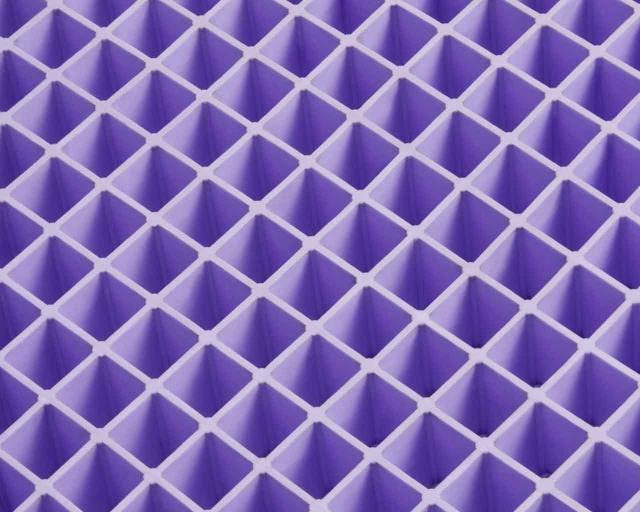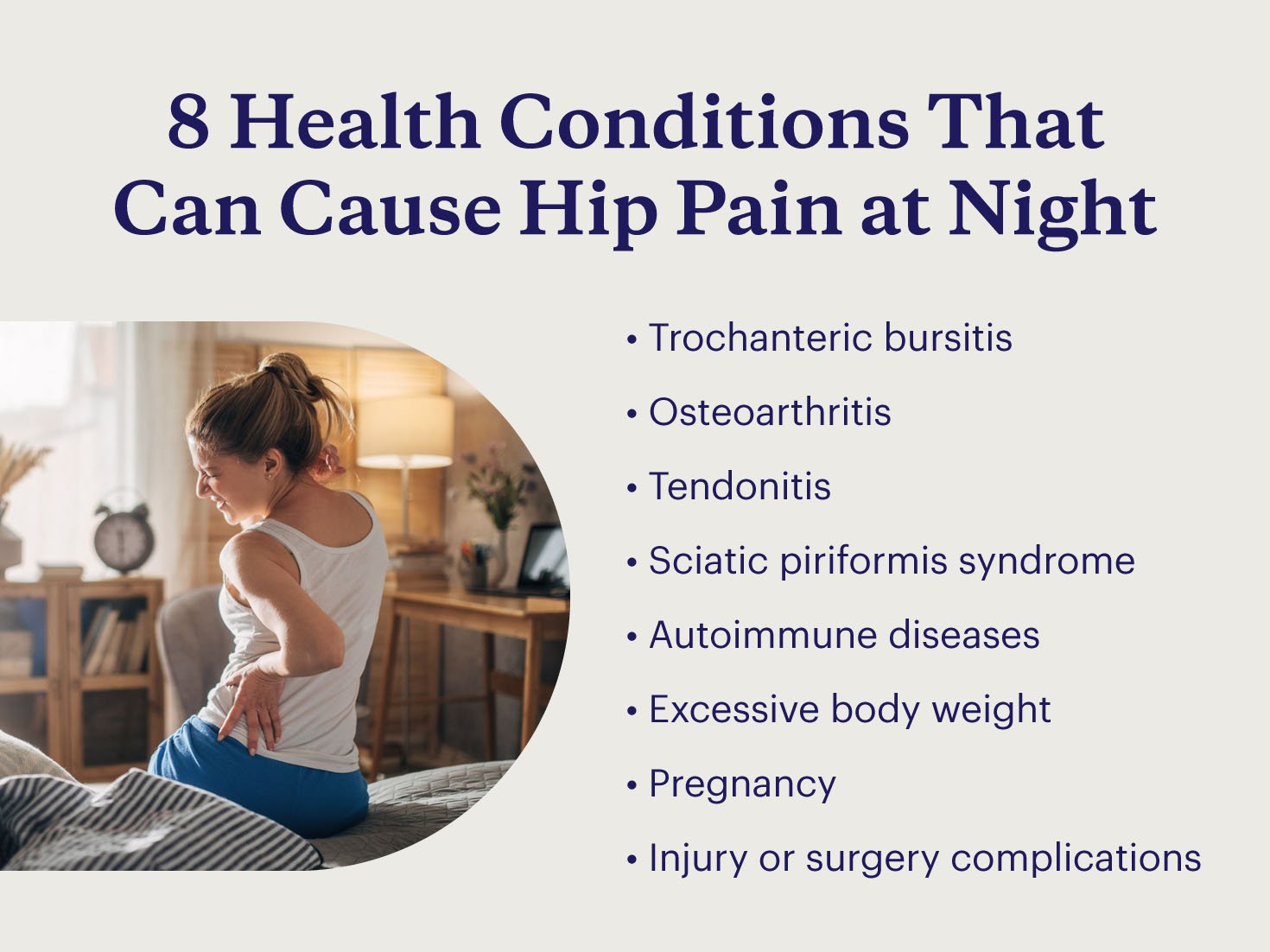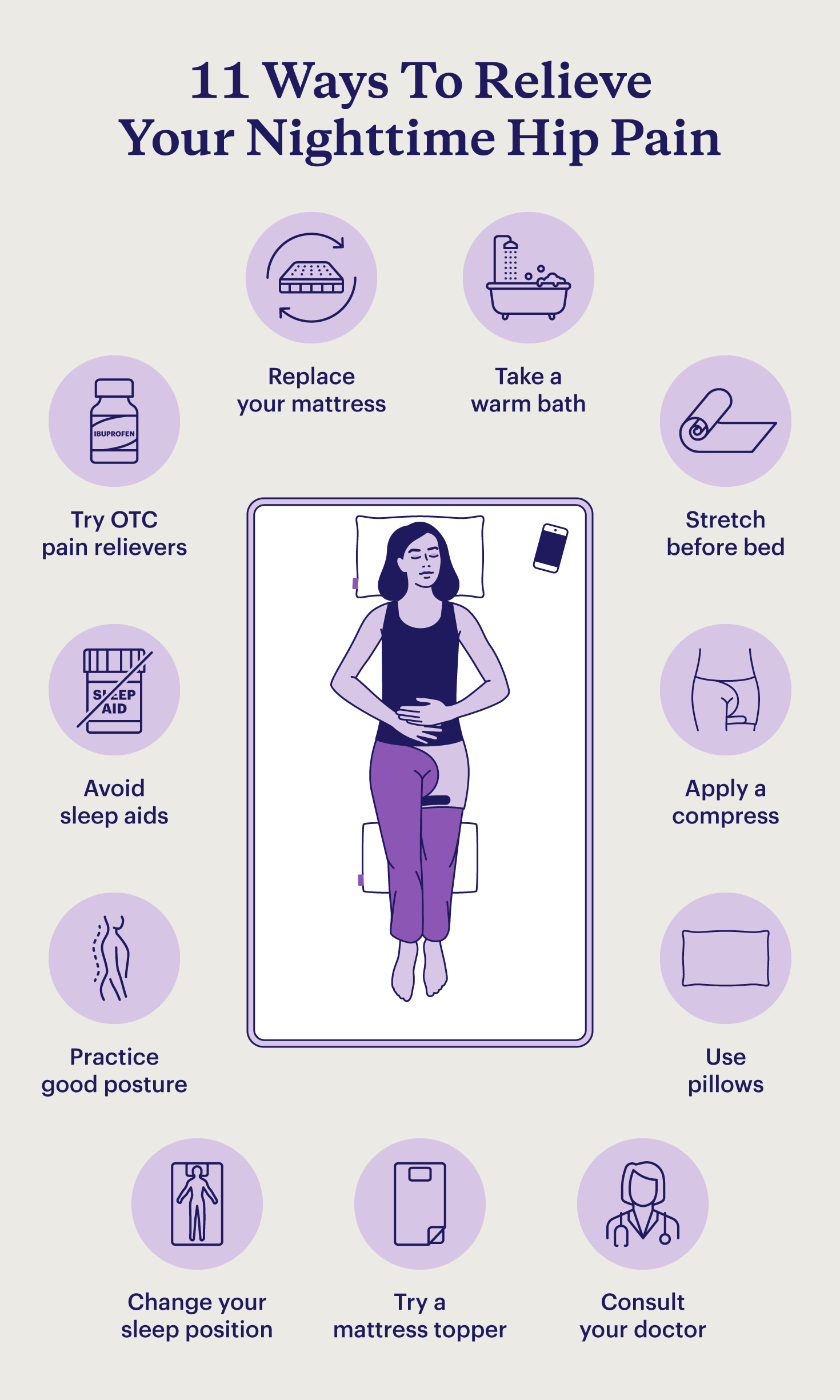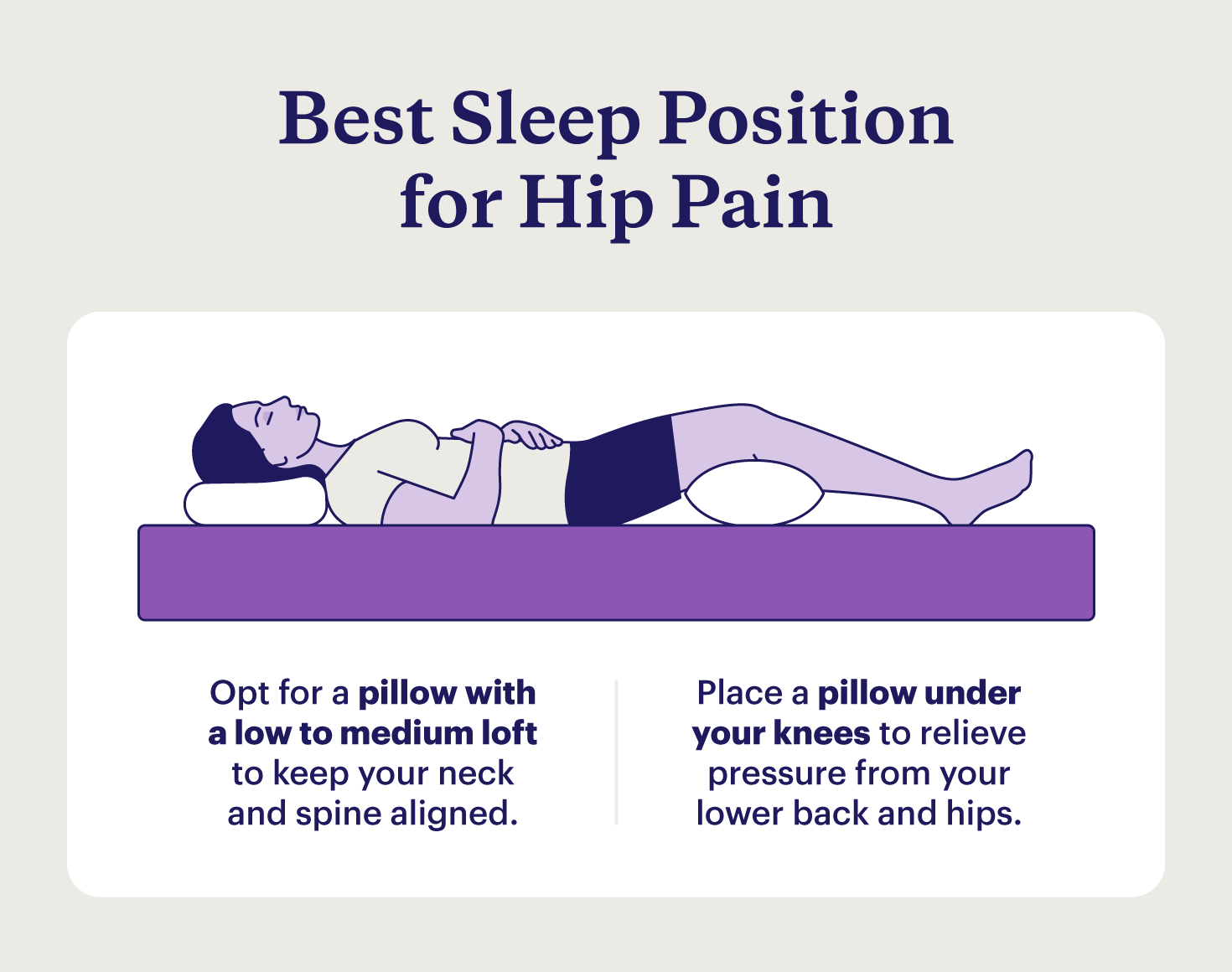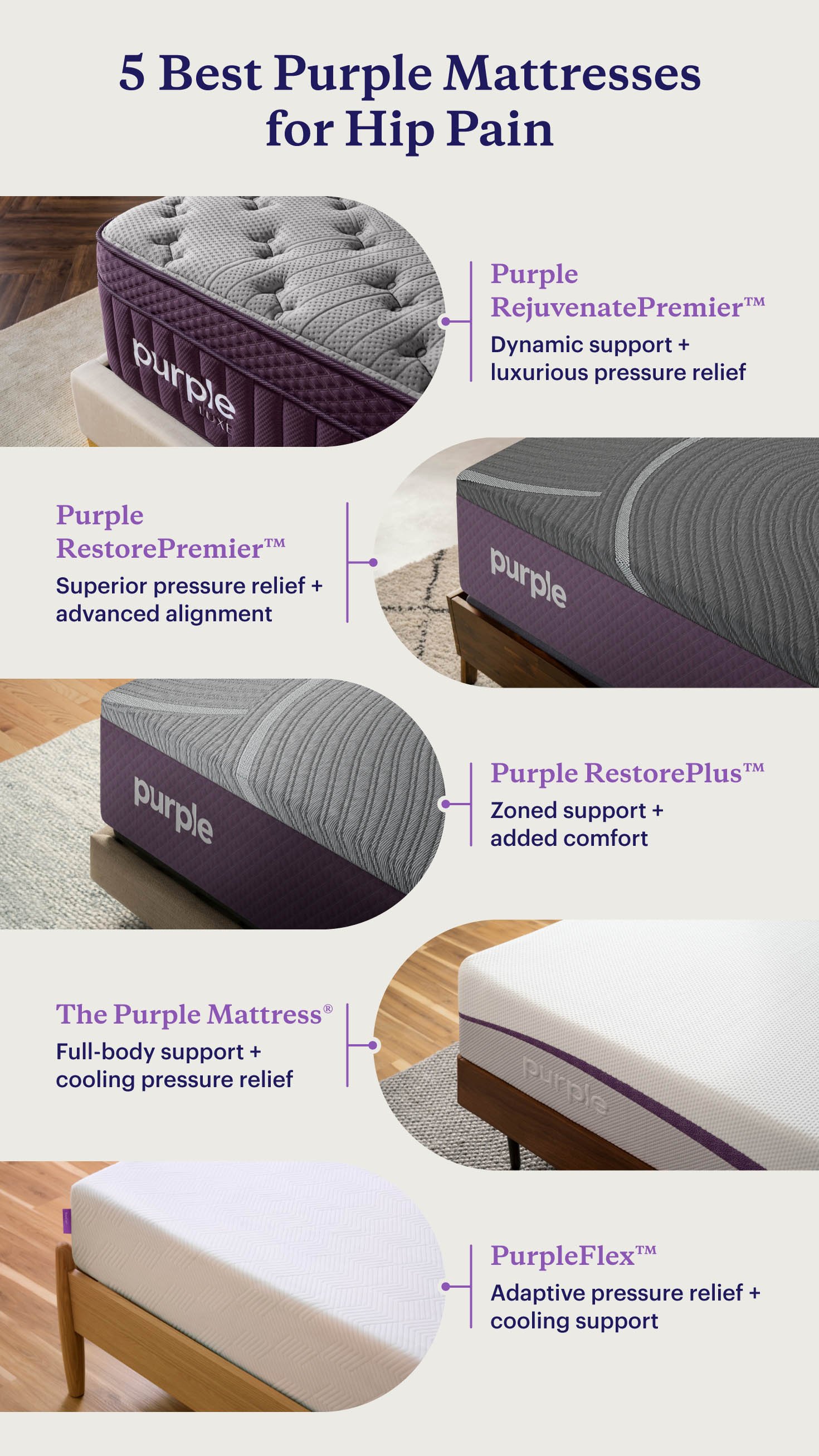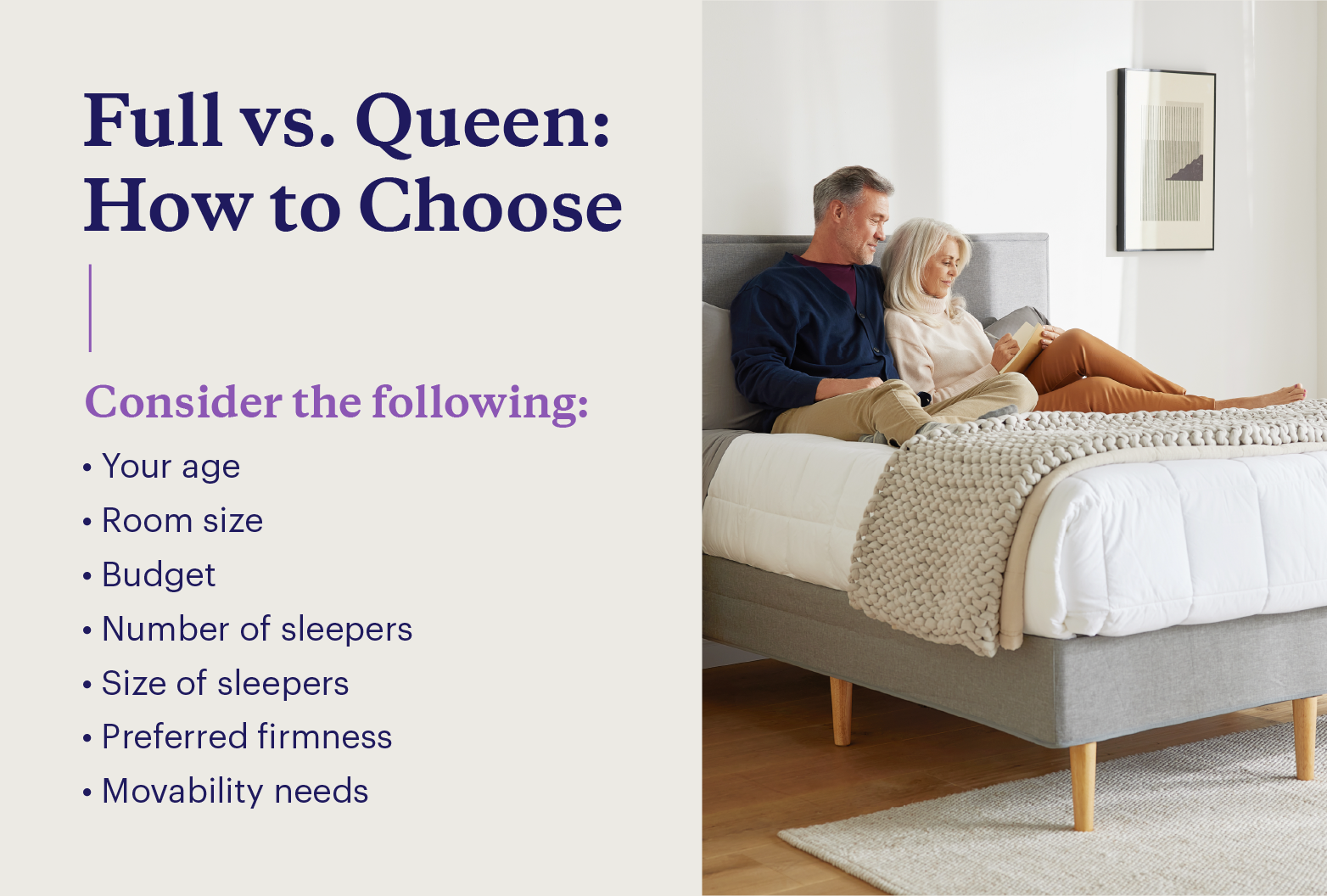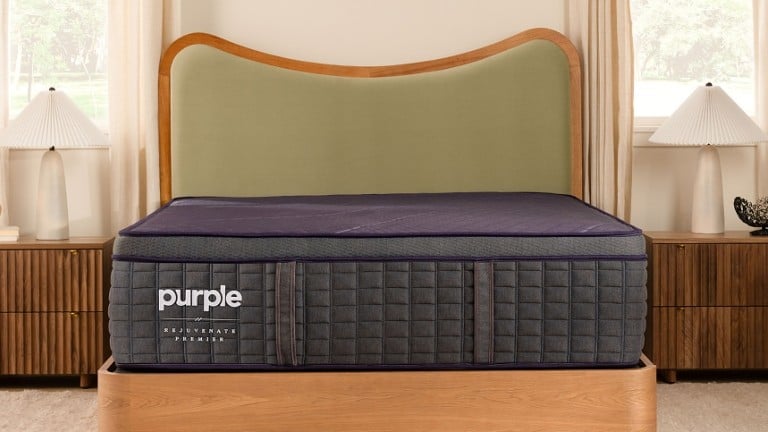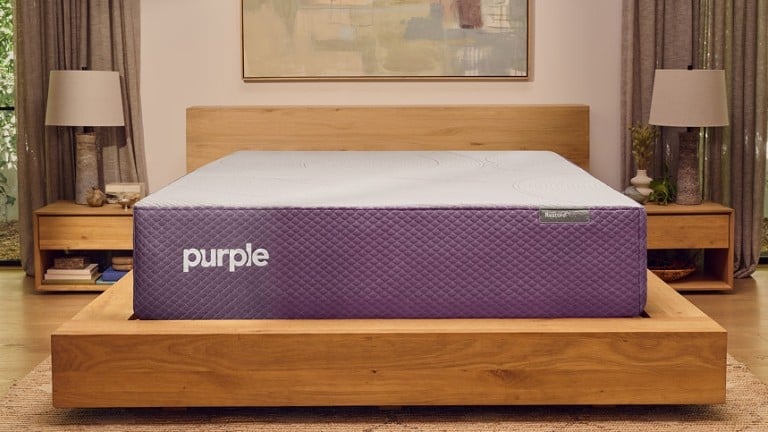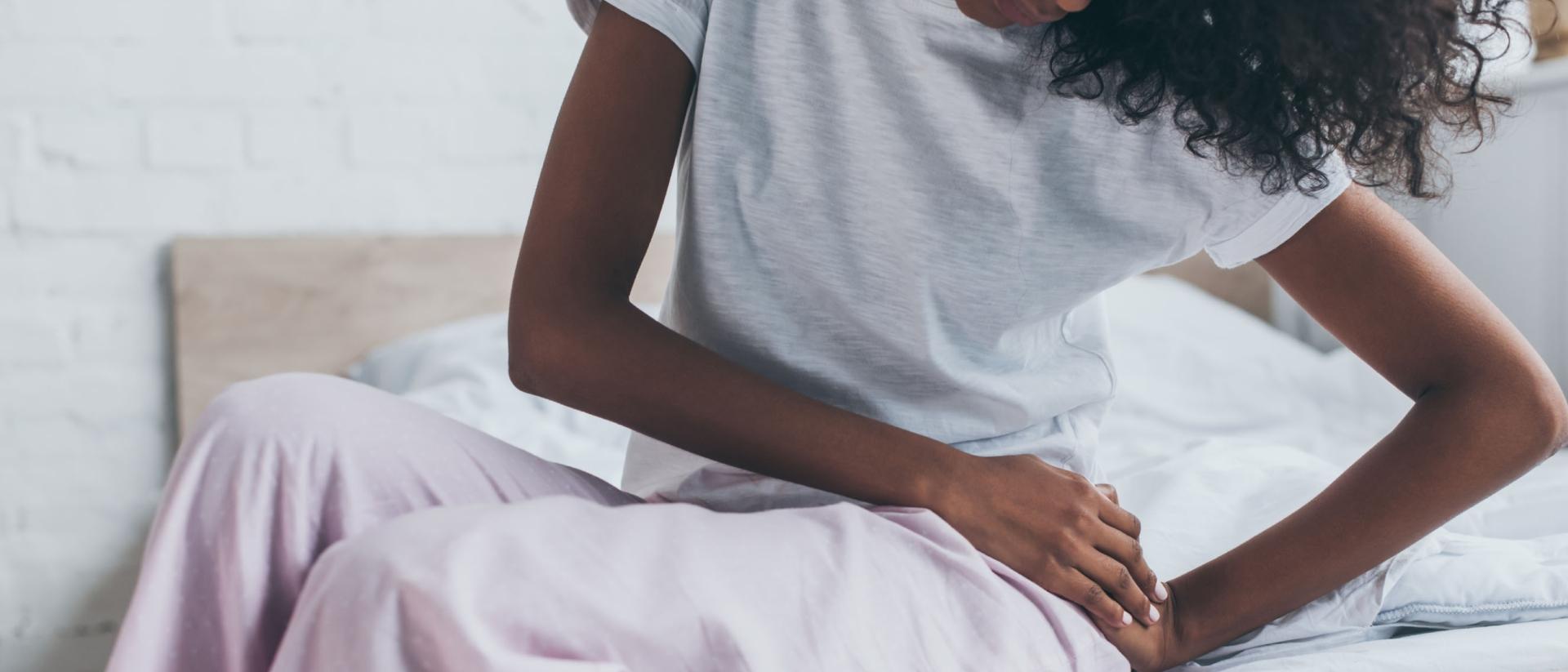
Can a Bad Mattress Cause Hip Pain? Best Mattresses for Hip Pain + Tips for Finding Relief
Key Takeaways
- Bad mattresses, poor sleeping positions, and health conditions can cause or worsen chronic hip pain.
- The best mattress for hip pain will support spinal alignment while offering pressure relief for your hips, though individual preferences may vary.
Chronic hip pain is a common issue that can reduce your quality of life and make it difficult to get the rest you need. Finding out the cause of your hip pain can help you identify the best way to relieve your symptoms. So, can a bad mattress cause hip pain?
Absolutely. An unsupportive mattress, sub-optimal sleeping positions, and underlying health conditions are some of the most common causes of hip pain at night.
If you can't get comfortable at night due to hip pain, there are a number of ways you can try to relieve your aches and pains. In this guide, we discuss some of the best ways to relieve hip pain when sleeping, how to choose a mattress that provides the most relief, and our recommendations for Purple’s best mattresses for hip pain.
- RejuvenatePremier® Hybrid
- RestorePremier® Hybrid
- RestorePlus® Hybrid
- The Purple Mattress®
- PurpleFlex™
Causes of Hip Pain at Night
If your hips feel stiff, sore, or achy, you have shooting pain in your hips, or you’re experiencing pain and numbness that radiates down your legs, you may have a hard time falling and staying asleep. Hip pain can reduce your sleep quality, but relieving your pain depends largely on the cause behind it.
The most common causes of nighttime hip pain include:
Your Sleep Position
Even if your sleep position feels natural and comfortable at first, it’s important to choose a position that keeps your spine aligned to help prevent back and hip pain. Some positions can worsen hip pain without proper support. Side sleepers, for example, may experience more hip pain while sleeping, especially if they lie on the side that hurts. Choosing the right mattress for side sleeping support can help alleviate pressure points and reduce discomfort.
Your Mattress
If you’re experiencing hip pain at night no matter what position you’re in, a bad mattress may be to blame. An unsupportive mattress that lacks the features you need can prevent your hip pain from improving and even worsen the issue.
Mattresses that are too soft or too firm can put unnecessary strain on joints like your hips, resulting in poor alignment and discomfort. Similarly, a worn-out or low-quality mattress won’t provide the support and pressure relief you need, making your hip pain worse.
Health Conditions
Hip pain can be a symptom of several medical conditions that may result from overuse, deterioration, or excessive pressure and nerve compression.
Some of the most common health conditions that cause hip pain include:
Bursitis
Though bursitis can affect any joint, trochanteric bursitis occurs when the fluid-filled sacs (bursae) cushioning your hip joints become inflamed. This condition can cause sharp, intense pain on the outside of the hip that can radiate to the thigh, making it difficult to sleep soundly.
Osteoarthritis
Degradation of cartilage in the hips can result in hip arthritis, causing inflammation, pain, and stiffness. Symptoms can worsen after standing, walking, or sleeping, disrupting your sleep night after night. Sleepers should choose a mattress for joint support and pressure relief to reduce pain.
Tendonitis
Inflamed tendons are often the result of overuse or injury, resulting in swelling, pain, or general discomfort. Hip tendonitis can develop from sports like gymnastics or running but can also occur from carrying your weight on one leg or keeping your legs crossed too long.
Sciatic Piriformis Syndrome
Piriformis syndrome entails spasms of the piriformis muscle in the buttocks, causing pain and compressing the sciatic nerve. This condition can result in hip pain as well as sciatica symptoms while sleeping, such as radiating numbness and tingling.
Autoimmune Diseases
Autoimmune diseases like lupus, rheumatoid arthritis, and multiple sclerosis can cause hip pain when the body’s immune system attacks the joints, causing inflammation, swelling, and stiffness.
Excessive Weight
Carrying more weight on your body puts added pressure on your joints, contributing to deterioration and a higher risk of injury. While it may not be the sole cause of your hip pain, a higher body weight can worsen your symptoms, making it difficult to get the rest you need.
Pregnancy
Hip pain can occur at any stage of pregnancy and can be exacerbated by weight gain, reduced movement, and hormonal changes.
When you’re pregnant, your body releases hormones that relax the connective tissue, joints, and ligaments in your pelvis, increasing your body’s flexibility to allow your baby to pass more easily when you’re in labor. While this process helps ensure your delivery goes smoothly, loose ligaments and shifted pelvic bones can cause pain, especially when sleeping on your side during pregnancy.
Injury or Surgery
In most cases, you’ll know when your hip pain is caused or worsened by an injury, resulting in stress fractures, soft tissue tears, or infections. Whether you had a bad fall or were in a car collision, acute injuries to the hips require medical attention, so contact your doctor immediately if you’ve suffered a hip injury.
You may also experience pain after undergoing hip surgery. Inflammation and nerve issues are not uncommon after a hip replacement, but excessive swelling and pain may be an indicator of an incompatible replacement, infection, or tendonitis. If you’re concerned about pain after surgery, contact your doctor to identify the cause and get the correct treatment.
How To Relieve Hip Pain While Sleeping
If hip pain is keeping you up at night, finding ways to safely alleviate your discomfort can help you sleep better and improve your quality of life. Here are 11 tips for relieving your hip pain at night.
1. Replace Your Mattress
Your mattress plays a major role in your comfort and sleep quality, so if your hip pain isn’t improving or is getting worse, your mattress may be part of the problem. It may be time to replace your mattress if:
- It’s started to sag
- It feels too firm or too soft
- It doesn’t provide the pressure relief you need
- You’ve had it for over seven years
Mattress lifespan varies depending on materials, construction, and quality, but as a rule of thumb, if your mattress isn’t as comfortable as it used to be, a replacement may be necessary.
Deciding what mattress to get as a replacement depends largely on your unique preferences and needs. When shopping for a new mattress, look for one that relieves pressure from sensitive areas like your hips while still supporting broader surfaces like your back to help promote proper spinal alignment.
Purple Restore Hybrid Collection mattresses are designed with this balance in mind. Featuring the GelFlex Grid paired with responsive hybrid support, they adapt to your body as you move, cradling pressure points without sacrificing stability. In a recent SleepScore Labs study, sleepers on a Purple Restore Collection mattress reported 63% less sleep-interfering pain, helping support more comfortable, uninterrupted rest and better sleep quality over time17.
This combination of targeted pressure relief and consistent support can be especially beneficial for sleepers who wake up sore, shift positions throughout the night, or struggle to stay asleep due to discomfort.
2. Change Your Sleep Position
One of the best positions for relieving hip pain and keeping your spine aligned is sleeping on your back. This position keeps your spine aligned and prevents you from putting too much pressure on your hips.
You can teach yourself how to sleep on your back to help relieve your hip pain, but if you've been a side sleeper for years, changing your preferred sleeping position won't always be easy. You can alleviate some hip pain by sleeping on the side that doesn’t hurt and placing a pillow between your knees to promote correct spinal alignment.
Stomach sleepers may find that the position provides some hip pressure relief, but they may wake up with neck pain or lower back pain because their spinal alignment is off-kilter during the night. Placing pillows under your pelvis to support the curve of your spine and provide pressure relief can make this position healthier and more comfortable, but you can also try to train yourself to sleep in a different position to relieve your pain.
3. Use Pillows for Relief
The type and quality of your pillows, as well as how you sleep on them, impact the quality of your sleep. A good pillow will keep your neck and shoulders aligned throughout the night.
If you sleep on your back, place a pillow under your knees and use a low to medium loft pillow for your head and neck to keep them aligned. Stomach sleepers can place a pillow under their pelvis to reduce pressure on the spine and relieve pain.
The best pillows for side sleepers are often medium-firm to firm with a medium loft to keep your neck aligned and support your head. If you’re struggling with hip pain as a side sleeper, try sleeping on the non-achy side with a pillow like the Purple Harmony Anywhere™ Pillow between your knees to align your hips and spine.
4. Stretch Before Bed
Stretching out your hip muscles and tendons before lying down can help you get a good night’s sleep. Stretch before you go to bed, when you wake up, and throughout the day if severe hip pain prevents you from relaxing.
If you work in a setting where you have to sit for long periods of time, take periodic stretch breaks during the day to keep your muscles loose and provide pain relief. Gentle stretches and light yoga are often good places to start, but it’s important to know your physical limits and listen to your body. If a stretch feels uncomfortable or causes more pain, you should consult your doctor for advice.
5. Practice Good Posture
Try to maintain good posture while standing, sitting, and sleeping to promote spinal alignment and prevent hip pain. When you go to sleep, make sure your back is in a neutral position that aligns with the natural curvature of your spine.
Keeping your shoulders back, chin up, and back straight while standing and sitting can help condition your spine to maintain its natural curves, reducing your risk of back and hip pain when you go to sleep.
6. Take a Warm Bath Before Bed
Soothe pain and reduce stiffness by increasing circulation when you take a warm bath or shower before bed. It can also be beneficial to perform your stretches after taking a warm bath, as the heat can help loosen your muscles and make it easier to stretch.
7. Apply a Compress to the Affected Area
You can get comfort from using ice or heat therapy on your aching hips. Heat can keep muscles and tendons loose, relaxed, and comfortable during the night. This works best for people suffering from muscle spasms, arthritis pain, and general stiffness.
Applying ice can help reduce swelling and inflammation, which can be helpful for hip pain caused by an injury.
8. Try Over-the-Counter Pain Relievers
Over-the-counter (OTC) nonsteroidal anti-inflammatory medications (NSAIDs) like ibuprofen and naproxen can offer temporary relief from chronic hip pain. Talk to your doctor first about how often it’s safe to take them. You can also talk with your doctor about topical medications that help relieve chronic pain and increase your comfort.
9. Avoid Sleep Aids
After a few nights with no sleep, you might be tempted to try sleep aids. In the short term, sleep aids can be an effective way to fall and stay asleep, but if you consistently rely on them, your body will build a tolerance, meaning you’ll need more medication to get the same effect.
It’s often best to avoid using sleep aids, as they won’t improve the root cause of your hip pain. Consult your doctor if your hip pain continues to disrupt your sleep after trying these tips.
10. Consider a Mattress Topper
If you can't say goodbye to your current mattress just yet, you can use a mattress topper, which sits on top of your mattress to provide pressure relief when your current mattress can't. You can find mattress toppers made with memory foam, latex, and cooling gels to suit your needs.
We don’t recommend using a mattress topper on Purple mattresses, as they negate the cooling, instantly adaptive benefits of the GelFlex® Grid.
11. Speak to Your Doctor
If you’ve already tried the above tips but hip pain still interferes with your sleep, it may be time to talk to your primary care doctor. They can help identify the underlying cause of your hip pain and create a care plan that may include physical therapy, steroid injections, or surgery.
Best Mattresses for Hip Pain
A good mattress helps you maintain neutral spine alignment throughout the night, providing relief for sleepers who suffer from hip joint pain. In contrast, an unsupportive and uncomfortable mattress can create additional pressure on your hips and worsen your pain.
The best mattress for hip pain will ultimately depend on your individual preferences and needs. We recommend the following Purple mattresses for their adaptive support, soothing pressure relief, and cooling comfort.
RejuvenatePremier®
The Purple RejuvenatePremier® is an elevated, luxurious mattress offering immersive pressure relief, enhanced comfort, and full-body support to keep your hips and spine aligned, especially for side sleepers.
- Feel: Soft, immersive
- Key Features: Buoyant softness, full-body support, 25% more pressure relief material than the RejuvenatePlus®, minimal motion transfer, improved cooling with temperature regulation
- Materials: Smooth Gusseted Cover, DreamLayer™ Technology (MicroGrid + MicroAir™ Foam), 2” GelFlex Grid® layered with an additional 2” GelFlex Grid®, 1” Soft Adaptive Foam, 8” Pocketed Coils, 1” Base Foam
- Sizes: Twin XL, queen, king, California king, split king
- Price: $$$-$$$$
We now carry an improved version of the Rejuvenate® Luxe Collection, designed to maximize your comfort and help you sleep better. The original RejuvenatePremier® Mattress was our most indulgent mattress; this upgraded model provides an even more luxurious experience.
“This mattress is heaven. I cannot remember the last time I had a perfect night’s sleep. No tossing, no turning, no waking up during the night to go sleep on the couch. My husband has a bad back and he has seen some improvement with comfort during the night. This in and of itself was worth the money spent. We both actually feel rested when we wake up.” — Renee W., Original RejuvenatePremier® review
While the new RejuvenatePremier® offers enhanced pressure relief and support, the first iteration was an indulgent hybrid mattress that has earned rave reviews and awards from reputable sources, including:
- Health: Most Comfortable Mattress1
- Amerisleep: Best Luxury Mattress2
- The Spruce: Best Euro Top Mattress3
Purple RestorePremier®
Enhance your sleep quality with the RestorePremier®, designed for superior pressure relief and comfort. This hybrid mattress combines contouring foam with our GelFlex Grid® for pressure relief, plus individually wrapped coils for structured support to keep your body aligned and comfortable.
- Feel: Two feel options
- Key Features: Up to 4x cooler* than competitors with temperature balancing technology, pin-point pressure point relief, and dynamic support
- Materials: 3” GelFlex® Grid, Ultra Comfort Foam, Coolflex™ Coils, Advanced Edge Support System, moisture-wicking breathable cover
- Sizes: Twin XL, queen, king, California king, split king
- Price: $$-$$$
*Disclaimer: Thermal test and heat flux study conducted by Purple on Purple hybrid mattresses in 2023.
“I've suffered with side hip pain from some hip joint problems and side hip pain from tendinopathy. This mattress allows me to sleep on my side without pain! I also like that it does not build up dust mites like traditional upholstered mattresses, as I have some issues with dust allergy.” — Leanne, Purple RestorePremier® review
This innovative hybrid mattress provides a tailored sleep experience, making it a great option for relieving hip pain and earning the following awards:
- Forbes: Best Pressure-Relieving Mattress for Side Sleepers4
- NBC: Best Hybrid Mattress for Back Pain5
- Forbes: Best Mattress for Sciatica Pressure Relief6
- Healthline: Best Support Hybrid Mattress for Hip Pain7
Purple RestorePlus®
The Purple RestorePlus® Hybrid Mattress features GelFlex® Grid for enhanced pressure point relief and zoned support for spinal and hip alignment.
- Feel: Two feel options
- Key Features: Up to 3x* cooler, advanced pressure relief, and targeted support
- Materials: 3” GelFlex® Grid, zoned Edge-to-Edge Coil Support System, Ultra Comfort Foam, moisture-wicking antimicrobial cover
- Sizes: Twin XL, full, queen, king, California king, split king
- Price: $$-$$$
*Disclaimer: Thermal test and heat flux study conducted by Purple on Purple hybrid mattresses in 2023.
“This bed has helped my family immensely. I get a much better night’s rest. My wife also gets a better night’s rest and is relieved of all her hip pain. This bed is amazing and you can't go wrong with it. I no longer sleep hot and wake up restored and rejuvenated.” — The Santi Family, Purple RestorePlus® review
Refinery29 named the Restore® Hybrid Mattress the best non-memory foam mattress for back pain, and the Purple RestorePlus™ Hybrid Mattress elevates the pressure relief, comfort, and support for an enhanced sleep experience.8 The RestorePlus® has also earned the following awards:
- Good Housekeeping: Best Mattress for Heavy People With Back Pain9
- Esquire: For the Best Side Sleep of Your Life10
The Purple Mattress®
The original Purple Mattress® features our innovative GelFlex® Grid, providing unparalleled pressure relief, cooling, and broad support. Our flagship mattress instantly adapts to your body, cradling your pressure points and supporting the alignment of your hips and spine to keep you comfortable.
- Feel: Medium-firm
- Key Features: Great pressure relief, temperature balancing, durable support
- Materials: 2” GelFlex® Grid, Durable Base Foam, Edge Support Foam, Comfort Foam, SoftFlex Cover
- Sizes: Twin, twin XL, full, queen, king, California king, split king
- Price: $-$$
“It helped me sleep with my bad hip! I was finally able to rest and get good rest! That helped my energy level and I was able to continue my health regimen to lose weight and after a year I was able to have my hip replacement surgery!” — Veronica D., Purple Mattress® review
This innovative mattress provides a unique, tailored sleep experience, earning the following awards:
- Good Housekeeping: Best Cooling Mattress for Back Pain11
- CNET: Best Mattress for Side Sleepers With Shoulder and Hip Pain12
- Eachnight: Best Flexible Mattress for Hip Pain13
- Prevention: Best Cooling Mattress for Back Pain14
- Healthline: Best Mattress for Hip and Shoulder Pain15
PurpleFlex™
Offering breathable, cooling support and pressure relief for your back, shoulders, and hips, the PurpleFlex™ mattress contours to your body to keep you cool, comfortable, and as pain-free as possible. This mattress may be best suited for back sleepers with hip pain, promoting spinal alignment and relieving pressure from the back and hips.
- Feel: Firm
- Key Features: Soothing pressure relief, temperature balancing, stable base support
- Materials: 2” GelFlex® Grid, high-density Durable Base Foam
- Sizes: Twin, full, queen, king
- Price: $-$$
“I have never slept better in my life. I used to wake up with back pain every morning because of my mattress, but now I can't remember the last time I woke up with a sore back because of my Purple mattress. Would definitely recommend.” — Sarah S., PurpleFlex™ review
Great for relieving hip pain and pressure without trapping heat, the PurpleFlex™ mattress has earned the following award:
- Mind Body Green: Best Mattress for Chronic Hip Pain16
How To Choose a Mattress for Hip Pain
If you’re struggling with hip pain, you’ll need a supportive mattress that cradles your hips. There is no one-size-fits-all type of mattress for hip pain, and the best mattress for sleepers with hip pain is one that suits your individual needs and preferences. There are six main factors to consider when choosing a mattress for hip pain relief.
Firmness
Mattress firmness ranges from soft (or plush) to firm, and it’s important to consider your needs and comfort preferences to determine the right firmness for you. Sleepers with hip pain often prefer a medium-firm feel that supports their back and offers pressure relief around the hips and lower back. You may choose a different firmness depending on factors like your size and preferred sleep position.
Softer mattresses let sleepers sink into the mattress, providing a contoured, hugging feel. This type of mattress is often best for light sleepers and some side sleepers, though individual preferences vary.
Heavier people and stomach sleepers often sleep better on firmer mattresses that provide more lift and support, keeping your spine aligned. A softer mattress or one that sinks under you like memory foam may cause back discomfort. Medium-firm mattresses are generally good choices for sleepers of all types and especially back sleepers, blending the pressure relief and support of soft and firm mattresses.
Mattress Type
Different types of mattresses may offer more pressure and pain relief than others. Some of the most popular choices for hip pain relief include:
- GelFlex® Grid: Found in every Purple mattress, our innovative Hyper-Elastic Polymer material simultaneously cradles pressure points (such as your hips) and supports everywhere else (such as your back and legs) for proper spinal alignment. Open-air channels also provide cooling benefits.
- Foam: Memory foam and other polyfoams contour to your body, cradling your pressure points for relief, but foam that is too soft can put too much pressure on the hips and may trap heat.
- Innerspring: This is an affordable mattress option made with coils covered by a comfort layer to support your body. Innerspring mattresses often offer firmer support, which someone suffering from hip pain may prefer.
- Latex: Latex foam beds are some of the longest-lasting mattresses available, offering a bouncy, floating feel that disperses your weight to relieve pressure. They can be heavy and may not offer as much relief as other options.
- Hybrid: Blending the benefits of coils and foam, latex, or other materials, hybrid mattresses offer pressure relief and support, making them suitable for those with hip pain and heavier sleepers, though they may have a higher price point.
Those with hip pain often prefer these mattresses, but you should decide what feels most comfortable to you and best suits your needs.
GelFlex® Grid | Foam | Innerspring | Latex | Hybrid | |
Feel | Adaptive | Sinking | Springy | Floating | Responsive |
Pressure Relief | Cradles your joints | Contours to your body | Uneven support | Evenly distributes body weight | Supportive and contoured |
Durability | Hyper-elastic polymer is highly durable and long-lasting | Prone to sagging over time | Shorter lifespan | Long lifespan with proper care | Hybrid construction increases durability |
Considerations | Unique feel | May retain heat, trapped feeling | Poor movement isolation | Higher price point, can be heavy | Less motion isolation, higher price point |
Zoned Support
A mattress with zoned support features different materials and construction throughout the length of the bed, offering different levels of comfort and support to better align areas like your shoulders, back, and hips. Look for a mattress with tailored zones to relieve hip pain and support the alignment of your spine for maximum comfort.
Thickness
While mattress thickness doesn’t always translate to pain relief potential, a mattress with more layers of high-quality materials designed to provide pressure point relief and support your spinal alignment may be a good choice for those with hip pain. Look for mattresses that cradle your hips with comfort layers to relieve pain and help you sleep.
Your Sleep Needs
Everyone has different needs and preferences when it comes to finding the right mattress, so when you’re searching for the best mattress for hip pain, you may find that the mattresses others prefer don’t work for you.
Your preferred sleep position may affect what mattress will best relieve your hip pain. For example, the best mattress for side sleepers with hip pain may be different from what is best for a back or combination sleeper. If you're looking for a supportive mattress for side sleeper hip relief, the RejuvenatePremier® offers indulgent support, pressure relief, and sleep-changing comfort.
Depending on your weight and build, you may prefer different mattress materials, feels, and thickness. If you exceed the mattress weight limit, you may not get the support you need to relieve your hip pain.
Ultimately, you should pick a mattress that has the features you want and feels most comfortable to you.
Warranty and Trial
When you buy a new mattress online or in a physical store, you may not know exactly how comfortable it will be when you sleep on it night after night. Make sure the mattress you purchase has a generous sleep trial and good warranty to ensure you can test it and determine if it provides the hip pain relief you need.
Purple offers a 100-night sleep trial so you can get a feel for your mattress and decide if it’s right for you. If you determine it’s not a good fit before the end of your trial, you’ll get a full refund. We also offer a 10-year warranty on our mattresses so you can rest easily.
How Do I Know If My Mattress Is Causing My Hip Pain?
If you’ve been waking up stiff and sore, you may be wondering if a bad mattress can cause hip pain. A worn-out or incompatible mattress can cause or worsen hip pain, and if you’ve tried using tips to relieve your hip pain with no success, there’s a chance your mattress is the culprit.
Finding a good mattress is integral to ensuring a comfortable night's sleep. The best mattress for back and hip pain is a mattress that conforms to your body’s shape for pressure relief with enough firmness and support to keep your spine aligned.
Every Purple mattress features our innovative GelFlex® Grid, offering superior support and pressure relief for your hips and joints. Enhance your sleep quality and enjoy the breathable, cushioned feel of a Purple mattress to relieve your hip pain and rest well.
FAQ
While memory foam mattresses offer contoured pressure relief, it may be too soft for your needs if your body sinks too deeply, creating misalignment.
Memory foam can also lose its structure and durability over time, so if you’ve been sleeping on your memory foam mattress for a while, you may feel achy as it starts to sag and become less supportive.
With the adaptive GelFlex® Grid, Purple mattresses offer the benefits of memory foam without the downsides, keeping you cool and offering durable, soothing support and pressure relief.
If you believe your mattress is causing hip pain, it may be time to replace it for something that is more supportive and offers more pressure relief. When you get a replacement, be aware that new mattresses can cause short-term pain during the adjustment period.
You may need to break in your new mattress if your new pain doesn’t subside after the first month. Check the sleep trial and warranty details for your mattress before ordering to make sure you have the flexibility to determine if your new mattress is right for you.
Mattresses made with latex, foam, hybrid, and the GelFlex® Grid are often preferred by people with hip and back pain; these mattress types offer great pressure relief, especially around the hips.
A medium-firm mattress often provides the most relief and support for hip pain, cradling your joints and supporting the alignment of your spine. Whether you choose a soft or firm mattress depends largely on your personal preferences and what feels most comfortable.
If your mattress is too soft and causing you hip pain, you can try a few ways to make your mattress firmer, such as using a firm mattress topper or upgrading your base. If this doesn’t work, you may want to consider using a different mattress to prevent and relieve your hip pain.
In most cases, the best sleep position to relieve hip pain is on your back with a pillow under your knees to relieve pressure from your hips. You can also sleep on the side that doesn’t hurt with a pillow between your knees to keep your hips aligned.
More To Explore
Level up your sleep routine with our most-loved products.

